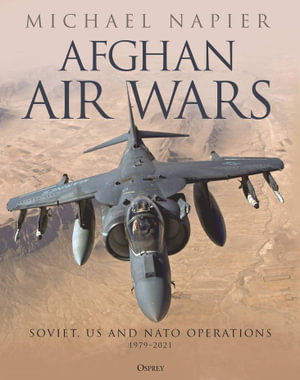| Sun | 10am – 5pm |
| Mon | 9am – 5:30pm |
| Tue | 9am – 5:30pm |
| Wed | 9am – 5:30pm |
| Thu | 9am – 5:30pm |
| Fri | 9am – 7pm |
| Sat | 9am – 5pm |
Ask our staff anything about our shop or products, or share your feedback.

PublishedOsprey Publishing, January 2024 |
ISBN9781472859013 |
FormatHardcover, 320 pages |
Dimensions24.2cm × 19cm |
Afghan Air Wars records and explains the critical role of air power in the skies over Afghanistan, not only over the last 20 years but also the ten-year occupation by the USSR in the 1980s, and draws parallels between the experiences of the aircrews of both NATO and the Soviet Union.
US and British forces, strongly supported by air power, invaded Afghanistan in late 2001 in response to the Al Qaida attacks on '9/11'. What began as a small-scale operation of 2,500 troops with the limited objective of destroying Al Qaida became ever larger, growing to over 100,000 troops ten years later. This experience matched that of the Soviets after their invasion in late 1979, when they saw a massive increase in resistance by Mujahidin. Soviet aircraft, such as the MiG-21, MiG-23, Su-17 and Su-25, as well as Mi-8 and Mi-24 helicopters supported Soviet offensives in the Panjshir Valley and other regions. There were also engagements with both Pakistani and Iranian aircraft. Some 20 years later, US and NATO air forces were deployed in similar roles as the security situation deteriorated: the number of specialist tactical aircraft and helicopters based in Afghanistan increased, and heavy bombers such as the B-52 and B-1 were called in to carry out air strikes. After five years the Soviets attempted to transfer the burden of fighting the Afghan national forces, but these quickly collapsed once Soviet support was reduced; the NATO attempt to do the same thing met with a similar result.
The US and NATO aircraft (F-15E, F-16, F/A-18, A-10, Mirage, Harrier and Tornado, as well as CH-47 Chinook and AH-64 Apache helicopters) operated in a hostile environment and the advent of high-resolution targeting pods and Precision Guided Munitions (PGM) enabled aircraft to stand off from threat areas and also to deploy their weapons with deadly accuracy; the weapons themselves were designed to minimize collateral damage, with the result that airstrikes could be carried out with surgical precision. Operating both from in-country and bases and aircraft carriers elsewhere in the Middle East, US and NATO aircraft relied heavily on Air-to-Air Refuelling (AAR) support for most missions, adding to the variety and complexity of the air forces in the region. The conflict also saw the introduction of Remotely Piloted Vehicles (RPV) into routine air operations.
Afghan Air Wars will be richly illustrated with over 240 images - a mix of high-quality official photos and privately taken (in theatre) photographs which have not been previously published. It will also include many first-hand accounts by aircrews involved to create a unique history that will offer a comprehensive picture of the part played by air power over Afghanistan in the last 40 years.

